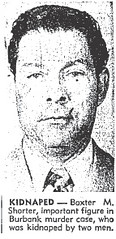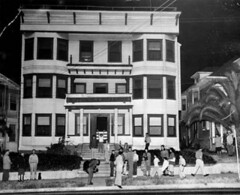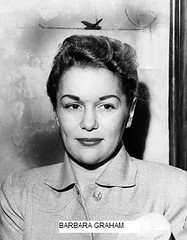
121 North Flower Street
April 15, 1953
The most sensational trial of 1953 has to have been that of Barbara Graham. The defendant was accused, along with Jack Santo, Emmett Perkins, Baxter Shorter, and John True of the beating death of Mrs. Monahan during a home invasion robbery. The crime itself was so banal that it may not have made it to the front page of the LA Times at all, and it definitely wouldn”™t have stayed there for as long as it did had it not been for Barbara, an attractive 29 year old prostitute and drug addict.
The story had all of the elements of a lurid tale from a sleazy detective magazine. Barbara Graham, abandoned by her  teenaged mother in
teenaged mother in
The crime itself was apparently the result of misinformation given to Perkins. He was told that Mrs. Monahan (former mother-in-law of Las Vegas gambler Tutor Scherer) had a sack full of money and jewelry that she kept in her home (the same kind of tragic misunderstanding would result in the brutal murder of the Clutter family in Kansas in 1959, and become the subject of Truman Capote”™s brilliant novel, “In Cold Blood”).
On the night of March 9, 1953, the gang drove to Mrs. Monahan”™s home in

It wasn”™t until the suspects had been identified and arrests had been made that the tale would take a turn onto
Baxter and his wife Olivia lived in an apartment at 121 N. Flower, and it was from that location that Shorter was kidnapped by two men. In a photo shown to her by police, Olivia identified one of the kidnappers as Emmett Perkins. The other man was almost certainly
the kidnappers as Emmett Perkins. The other man was almost certainly
Barbara maintained her innocence until the end. Being a mother of three, she may have avoided the death penalty if she hadn”™t made the mistake of offering a fellow inmate $25k to provide her with an alibi for the night of the murder. Unfortunately for her, the cellmate was actually a cop, planted to befriend her and gather information. Barbara”™s blunder had doomed her to death. Santo, Perkins, and Barbara would all die in San Quentin”™s gas chamber on the same day.
hadn”™t made the mistake of offering a fellow inmate $25k to provide her with an alibi for the night of the murder. Unfortunately for her, the cellmate was actually a cop, planted to befriend her and gather information. Barbara”™s blunder had doomed her to death. Santo, Perkins, and Barbara would all die in San Quentin”™s gas chamber on the same day.
Graham”™s execution was the paradigm for cruel and unusual punishment and would be the topic of many impassioned editorials, even by supporters of the death penalty. On the morning of her execution she”™d dressed in a beige wool suit and brown pumps, and had tried to prepare herself to face death. She was scheduled to die at 10:00 am on June 3, 1955, but was granted a stay until 10:45 am. Her execution would be delayed one more time, causing Barbara to ask “Why do they torture me?” Finally at 11:28 am Barbara was blindfolded at her request, and was led from the holding cell to the gas chamber.
In a macabre moment the executioner, Joe Feretti, gave the condemned woman a bit of advice: “Now take a deep breath and it won”™t be so bad” ”“ to which she replied, “How the hell would you know?”
For a fictionalized account of Graham”™s story, rent a copy of the 1958 film, “I Want to Live!” starring Susan Hayward.

